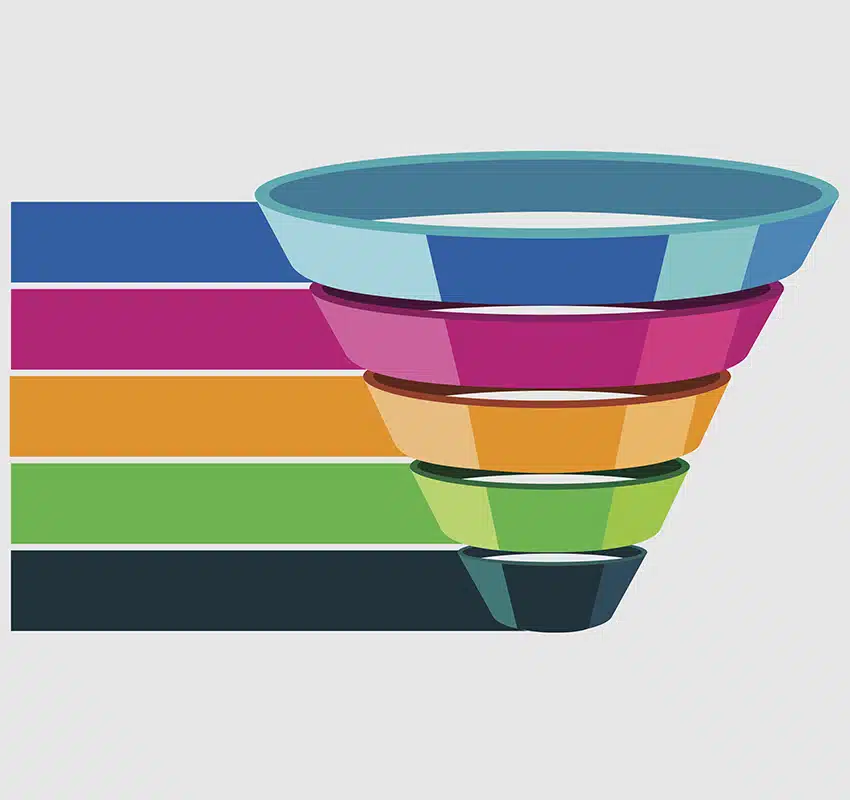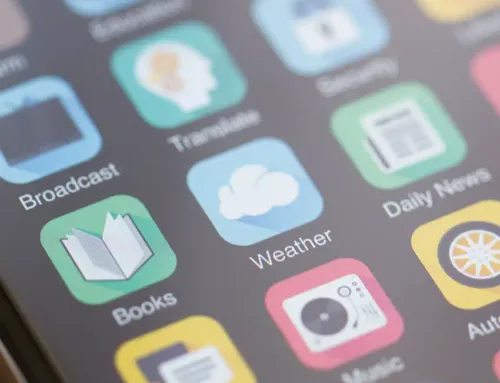Full Funnel Advertising
Full-funnel advertising involves engaging customers at every stage of their buying journey, from becoming aware of your brand to making a purchase. This article will guide you through effective strategies to build trust, nurture prospects, and drive consistent conversions. So, let’s explore together how Gourmet Ads’ full-funnel approach can drive awareness, build trust, and capture sales opportunities you might be missing.
Key Takeaways
- Full-funnel advertising is a comprehensive strategy that engages customers at every stage of their buying journey, from awareness to retention, focusing on relationship-building and trust.
- Each stage of the full-funnel approach, awareness, consideration, conversion, and retention, requires tailored content and tactics to effectively guide customers towards making a purchase and fostering loyalty.
- Utilizing marketing automation and multi-channel strategies enhances efficiency and effectiveness in full-funnel advertising, while measuring performance via key metrics is crucial for optimizing future campaigns.
Understanding Full-Funnel Advertising
This comprehensive marketing funnel approach guides consumers from initial awareness to conversion and loyalty, ensuring long-term engagement, improved customer satisfaction, and stronger retention. This method is particularly effective in today’s fragmented landscape, where customers interact with brands through various marketing channels such as social media, websites, physical stores, reviews, and paid advertising. Optimizing your marketing efforts across these channels ensures a consistent, positive experience throughout the journey.
Understanding customer needs at every stage is key to a successful full-funnel marketing strategy. This involves mapping user personas, setting measurable goals, and tracking progress with key performance indicators (KPIs). Mapping the customer journey helps identify their questions, decisions, and actions at each funnel stage, ensuring alignment with their expectations and behaviors.
Building Trust and Driving Conversions
A full-funnel strategy aims for sales while building relationships and trust. Minimizing friction and providing relevant value enhances customer experiences, guiding them seamlessly from awareness to conversion. Brands that implement full-funnel strategies have seen up to a 30% increase in conversion rates, demonstrating the measurable impact of engaging customers throughout their entire journey. This holistic approach creates momentum from one stage to the next, ensuring your marketing messages resonate with your audience at the right time and place throughout the funnel.
Creating a Seamless Path to Purchase
In today’s multi-device shopping environment, where customers engage across mobile, social media, and other marketing channels, a strong sales funnel strategy is essential. Each stage of the funnel, from top to bottom, requires tailored tactics to guide prospects from awareness to conversion. This includes building brand visibility, capturing key customer information, encouraging decisive actions, creating a seamless path to purchase, and fostering long-term brand loyalty.
Key Components of a Full Funnel Strategy
A successful full-funnel strategy involves understanding audience needs, segmenting the audience effectively, and delivering consistent messaging across various channels. The key stages of this strategy are:
- Awareness
- Consideration
- Conversion
- Retention
Each stage requires specific tactics to nurture prospective customers and guide them toward making a purchase, ensuring a seamless and cohesive customer journey.
Awareness Stage: Creating Brand Visibility
At the awareness stage, the primary goal is to educate potential customers about their challenges and introduce your brand as a trusted resource, without directly promoting a specific solution. This is the top of the funnel (TOFU), where the focus is on reaching a wide audience and capturing their interest.
Effective content formats for this stage include blog posts, infographics, and storytelling videos that highlight common pain points while subtly presenting your brand. To maximize reach, brands should use the channels their target audience frequents most, such as social media platforms, blogs, and online communities. Interactive content like quizzes, polls, or surveys can further increase engagement and attract new leads.
The aim here is to build trust and brand recognition, creating a strong foundation for future interactions. Examples of tactics include:
- Sharing free educational resources or guides to establish credibility.
- Sending short, value-driven email series to nurture early interest.
- Hosting free webinars or live Q&A sessions to build authority and encourage audience participation.
By offering helpful, non-promotional content, brands can make a positive first impression and start building relationships that guide potential customers further down the funnel.
Consideration Stage: Nurturing Potential Customers
During the consideration stage of a full-funnel marketing strategy, the goal is to educate potential customers and position your brand as the preferred choice. At this stage, prospects are actively exploring solutions and comparing their options, making it essential to highlight your brand’s unique value.
Middle-of-funnel (MOFU) strategies include offering in-depth content such as case studies, comparison guides, how-to resources, and testimonials that build trust and support decision-making. Hosting webinars, live demos, or Q&A sessions can also help address questions and clarify doubts.
To maintain engagement, brands can leverage retargeting campaigns, tailored email sequences, and exclusive content offers that keep the brand top of mind. The focus here is on reducing uncertainty and confidently guiding prospects toward the purchase stage.
Conversion Stage: Turning Prospects into Paying Customers
The primary goal during the conversion stage is to motivate prospects to take the final step and make a purchase, turning them into loyal customers. Bottom-of-funnel tactics focus on simplifying the buying process, reducing friction, and addressing any last-minute hesitations.
Effective conversion-focused content and offers include free trials, product demos, limited-time discounts, or one-on-one consultations that encourage immediate action. Building trust is critical at this stage. Successful funnel strategies overcome objections, highlight the brand’s unique value proposition, and use strong calls to action to guide prospects confidently toward completing their purchase.
Retention Stage: Building Customer Loyalty
Post-sale marketing, including customer support, feedback gathering, and loyalty programs, encourages repeat purchases and lasting relationships. Investing in upper and mid-funnel strategies fosters long-term relationships with valuable customers, ensuring they continue to engage with your brand over time.
A cohesive full-funnel strategy enables brands to deliver consistent messaging across all consumer interactions, enhancing loyalty and boosting customer retention rates. Retaining existing customers is crucial because it costs significantly less than acquiring new ones. Post-sale efforts aim to strengthen these relationships, generate repeat business, and create referrals. For example, brands that offer recurring-use products, such as coffee capsules for espresso machines, can boost retention through refill subscriptions or exclusive member discounts.
Crafting Effective Marketing Messages for Each Funnel Stage
Tailoring marketing messages to resonate throughout the customer journey for the target audience is key. At the top of the funnel (TOFU), focus on addressing customer needs rather than promoting specific products. This generates awareness and interest without overwhelming potential customers with sales pitches.
As customers move through the funnel, personalized email sequences driven by automation can significantly increase purchase likelihood. Consumers are more inclined to buy from brands that tailor their messaging. This personalization can include targeted offers, relevant content, and timely follow-ups to keep potential customers engaged, ultimately impacting customer acquisition cost.
Consistent messaging across all stages of the funnel helps build trust and guide customers smoothly from one stage to the next. By understanding the specific needs and concerns at each funnel stage, marketers can craft messages that address these points effectively, ultimately driving conversions and fostering loyalty.
Multi-Channel Marketing: Reaching Your Audience Everywhere
Modern consumers engage with brands through multiple touchpoints during their purchasing journey. This makes a multi-channel marketing strategy essential for reaching a broad audience and catering to varying channel preferences. By leveraging multiple channels, marketers can ensure their messages reach potential customers wherever they are. Common touchpoints include:
- Website visits
- Blog exploration
- Social media engagement
- Email campaigns
- Online ads and retargeting campaigns
Many marketers overlook retargeting strategies, which can help re-engage potential customers who have previously interacted with the brand. Retargeting can be particularly effective in reminding potential customers of the brand and encouraging them to return and complete their purchase.
Neglecting bottom-funnel tactics like retargeting can result in significant missed revenue opportunities, as high-intent users may slip away without proper follow-up.
Consistent messaging across all channels maximizes campaign performance and strengthens brand perception. Collaboration among stakeholders, such as brand managers, content teams, and performance marketers, ensures a unified, well-coordinated approach that drives measurable results.
Leveraging Marketing Automation for Full Funnel Success
Marketing automation plays a vital role in improving efficiency and driving results across the entire sales funnel. By automating repetitive tasks such as lead scoring, ad retargeting, and campaign management, marketers can focus on strategy and creative execution rather than manual processes.
Automation enhances customer relationship management, email campaigns, nurturing workflows, and lead generation, helping brands qualify and capture leads more effectively. Real-time analytics from these tools provides actionable insights, allowing teams to assess performance and make data-driven improvements quickly.
By streamlining lead nurturing and retargeting, marketing automation ensures that no potential customer is overlooked. It maintains consistent engagement, delivers personalized experiences, and guides prospects smoothly through each stage of the funnel, ultimately increasing conversions and supporting long-term growth.
Measuring Full Funnel Performance
Tracking full-funnel performance is essential to understanding the effectiveness of your marketing strategy and optimizing future campaigns. Each stage of the funnel has unique key performance indicators (KPIs) that provide valuable insights into your performance marketing efforts, helping you fine-tune campaigns and allocate resources efficiently.
- Awareness Stage: Impressions, ad spend efficiency, ad clicks, website traffic, and blog post views indicate how well you’re capturing attention.
- Consideration Stage: Engagement metrics such as time on site, pricing page visits, demo requests, and content downloads show how effectively you’re nurturing interest.
- Conversion Stage: Key metrics include conversion rates, cost per acquisition (CPA), and the progression from marketing-qualified leads to sales-qualified or product-qualified leads.
- Retention Stage: Metrics like user retention rate, repeat purchase rate, and customer lifetime value (CLV) measure long-term engagement and profitability.
- Loyalty Stage: Net promoter scores (NPS), reviews, and customer referrals help assess brand advocacy and satisfaction.
Failing to act on these insights can limit growth and campaign success. Modern unified measurement tools make it possible to track both upper- and lower-funnel efforts with greater precision, ensuring that every stage of the customer journey is optimized for maximum performance.
Common Mistakes in Full Funnel Advertising and How to Avoid Them
A common mistake in funnel marketing is over-focusing on one stage, neglecting others, and reducing overall effectiveness. Balancing efforts across the entire funnel ensures each stage receives adequate attention and resources.
Neglecting multi-touch attribution is another common mistake in full-funnel advertising. Using multi-touch attribution to track interactions across channels provides a comprehensive understanding of the customer journey, allowing for optimized strategies.
Relying solely on bottom-funnel tactics can neglect customer trust and loyalty, resulting in diminishing returns. Adopting a full-funnel approach without addressing limitations leads to ineffective strategies. A balanced funnel marketing approach lowers customer acquisition costs and boosts overall success.
Future Trends in Full Funnel Advertising
Customer journeys are becoming increasingly complex, requiring brands to maintain consistent engagement across multiple platforms. Emerging technologies such as AI-driven insights and predictive analytics are reshaping full-funnel marketing, allowing for more precise targeting and highly personalized experiences. By leveraging vast datasets, these tools help identify patterns, predict customer behavior, and guide smarter marketing decisions.
Key trends shaping the future of customer interaction and search optimization include:
- AI-powered chatbots that provide instant, personalized support and guide customers seamlessly through their journey.
- Voice and visual search optimization is becoming essential as user search behaviors continue to evolve.
- Greater reliance on first-party data to build trust, improve targeting accuracy, and manage acquisition costs in a privacy-focused environment.
Brands that embrace these innovations and maintain a focus on data privacy will gain a competitive edge, creating more dynamic, relevant, and customer-centric full-funnel strategies.
Summary
Full-funnel advertising is a powerful strategy that ensures engagement with potential customers at every stage of their journey. From creating brand visibility in the awareness stage to nurturing potential customers during consideration, driving conversions, and building customer loyalty, each stage is crucial for a successful marketing strategy.
As we move forward, embracing trends like AI-driven insights, chatbots, and privacy-first marketing will be essential. The future of full-funnel advertising is bright, and by staying ahead of these trends, marketers can continue to optimize their strategies and achieve remarkable results.











